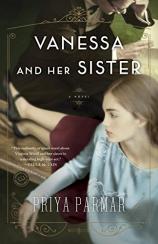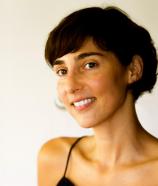Interview: January 22, 2015
Although VANESSA AND HER SISTER is only Priya Parmar’s second book (following her debut, EXIT THE ACTRESS), it has already wowed critics and readers. Set in the exhilarating days of prewar London, it tells the extraordinary tale of two gifted artists: Vanessa Bell and her sister, Virginia Woolf. In this interview with Bookreporter.com’s Roz Shea, Parmar talks about her fascination with Vanessa and Virginia, as well as the extended, equally eccentric Bloomsbury Group. She also discusses why she chose to tell the story in an epistolary format and why she hopes that the wonderful personalization of letter writing will not be lost in our technology-saturated world.
Bookreporter.com: What drew you to write a fictional biography about Vanessa Bell and her sister, Virginia Woolf, at a point in their lives before they became famous?
Priya Parmar: I was fascinated by who these people were before they knew that they would succeed in their various fields. When the novel opens, only E.M. Forster has made any headway in his career, and even for him, things were unsure. In 1905, he was about to publish WHERE ANGELS FEAR TO TREAD, but because it was his first novel and he did not yet have any clout, his publishers insisted he discard his original title, “Monteriano.” Vanessa Bell had not widely exhibited her painting. John Maynard Keynes was still in university and Virginia Woolf (then Virginia Stephen) had never published a novel. I wanted to write these characters before they knew the world was watching.
BRC: Where did you find material about their early lives? Were you able to find documented notes or references? How long did it take you to write the book?
PP: It took more than five years to finish the book. I spent two years just researching before I began to write. The Bloomsbury Group left an extraordinary wealth of primary material --- diaries, letters, postcards, photographs --- and their artistic work is all held in collections all over the world. Vanessa Bell’s letters are largely unpublished. There is a wonderful collection of her selected letters edited by Regina Marler, but there are hundreds of her unpublished letters held in archives.
BRC: What made you decide to use an epistolary format for the novel, a notable but unusual literary device used by Alice Walker in THE COLOR PURPLE? Also, I want to thank you for the “Cast of Characters” at the beginning of the book, which helped sort out who's who right from the start.
PP: I am so pleased that helped! In the first volume of Virginia Woolf’s letters, there is an invaluable glossary of the numerous affectionate nicknames they all used in their correspondence. At the start of my research, I would have struggled without it!
I had always planned to write the novel in a diary/epistolary format. These characters had such distinct, playful, individual letter writing styles and that would be lost if I shifted to the third person narrative. Vanessa Bell did not leave a journal, and that is a wonderful missing voice in the center of the group. I wanted to build a novel to fit that negative space.
BRC: The story plays out through telegrams, personal letters and diary entries, with interjections of some narrative chiefly through the main character, Vanessa. The men who would later marry the two sisters, Clive Bell and Leonard Woolf, were largely unknown during much of the novel, yet corresponded frequently with other characters throughout. I have to ask, who was this “Roger Fry” who wrote so forlornly to his mother and invalid wife? It would be a spoiler to explain here, but it served well to keep the pages turning to the Aha! moment. Leonard Woolf’s dispatches from Ceylon to his friend, Lytton Strachey, also foreshadowed coming events.
PP: It was difficult to figure out when to introduce Roger Fry’s voice. He is so important to how the novel resolves, and the First Post-Impressionist Exhibition played such a crucial role in the development of the group and the start of their notoriety that I knew I wanted him to speak and drive the narrative with his own voice, but it was tricky working out how. I am so pleased you feel that element worked!
Lytton Strachey’s letters to his dear friend Leonard Woolf were in the structure from the beginning. Lytton wrote so faithfully and consistently. He kept Woolf up to date with their evolving lives in London, and by 1909, he really was urging Woolf to return and marry Virginia.
BRC: The London-based Bloomsbury Group was loosely organized in the early 1900s by Adrian and Thoby Stephen, the two Cambridge-educated brothers of Vanessa and Virginia Stephen, and included some of the leading intellectuals of the time. Among them were author E.M. Forster, economist John Maynard Keynes, artist Henry Lamb, mountaineer George Mallory, and writer and critic Lytton Strachey, none of whom had achieved fame during the time of the novel. Do you think this group may have influenced the later creation of the Algonquin Round Table made famous during the 1920s in New York?
PP: I am really interested in the way that experimental, creative people flock together. It has happened throughout history. I think that just as the Pre-Raphaelites predated the Bloomsbury Group, so the Bloomsbury Group predated the Algonquin. Artists move in packs. They colonize and collect. There is a wonderful, tacit migration of artists, and each is influenced in some unknowable way by the groups that came before.
BRC: Strachey plays a prominent role in the sisters’ lives. His open homosexuality is fully accepted by the group, but of concern given Oscar Wilde’s infamous public humiliation and prison sentence. Sex is discussed among the men, but it is interesting to note that the sisters are treated as intellectual equals, not as objects to be pursued. Can you comment on this?
PP: At a time when women usually "withdrew" after supper, they were revolutionary. They spoke openly about homosexual and heterosexual sex in mixed conversations of men and women. And it was not sex that was legitimized by a redeeming force of true love. Often it was sex for sex’s sake, for both men and women. Their attitudes would have been considered forward and scandalous 50 years after the period I explore. Lytton was emotional and homosexual and heartbroken and verbal and indiscreet --- a dangerous combination in 1905. And Wilde had died only five years before the novel opens. There was genuine peril there, and they chose to disregard it.
BRC: The time frame of the novel falls during active women’s rights activities in England, yet these liberated sisters did not seem to be active in the suffrage movement. Was it common for well-read young women to take their freedoms for granted?
PP: Virginia Woolf in particular became active in the suffrage movement, but it was after the novel’s close. During this period, in the group, only Lytton Strachey’s sisters were active suffragettes. The Stephen sisters believed in equal rights but had not yet engaged in the issue publicly.
BRC: Their lifestyle indicates that money is no object. Vanessa, Virginia, and their brothers, Adrian and Thoby, seem to have no visible means of income except for occasional publication of newspaper columns by Virginia and rare sales of Vanessa’s paintings. Yet they enjoy sufficient wealth to generously entertain their friends with food and drink in the Thursday night sessions and the later extension to the Friday night art discussion group. They also enjoyed extensive foreign travel. Do you think this is important to the novel, or were these independently wealthy young people common in their social class?
PP: They did have private incomes but were not hugely wealthy. They had to be careful and live within their generous budgets. But they never owned their homes in Bloomsbury, and later, Vanessa Bell never owned Charleston Farmhouse. They rented. And Bloomsbury was not an expensive area. It was a suspect bohemian part of town and far from their affluent childhood neighborhood in Kensington.
The siblings of the Stephen family were not terribly unusual in terms of having their private incomes, but they were completely unusual in how they chose to spend them. Unlike most young people of their socioeconomic strata, their parents were dead, and so they were able to arrange their lives the way they chose with no parental input and oversight. That freedom and their bold choices are what set them apart.
BRC: Debilitating illnesses seem to plague each of the siblings at various times. Virginia's family and friends seemed to accept her periods of madness as almost normal. Was Virginia’s condition ever diagnosed? I understand that you met with Vanessa’s granddaughter after VANESSA AND HER SISTER was finished. Can you tell us about the meeting and her reaction to the book?
PP: It is thought now that Virginia Woolf was bipolar, but that is an approximate posthumous diagnosis based on anecdotal evidence of her symptoms. Her family did see them as normal, but then they had seen her experience these swings from mania to depression all her life. They also had seen their father, Leslie Stephen, battle what was likely depression and some form of mental difficulty.
I did meet the wonderful nonfiction writer, Virginia Nicholson, as I was finishing the novel. She is not only a writer I hugely admire (she wrote AMONG THE BOHEMIANS, which was an invaluable resource as I wrote this novel) but is Vanessa Bell’s granddaughter and Virginia Woolf’s great niece, and meeting her was a daunting, magical thing. Showing her the novel was an even more terrifying thing. But she was gracious and supportive and so lovely. She gave me careful line notes, pointing out which words her grandmother would have used (exhibition and not exhibit and napkin and not serviette --- genius and invaluable) and which expressions sounded out of step with the period. She is an extraordinary historical writer and has a perfect ear for period accuracy. And then she invited me to Charleston Farmhouse --- Vanessa Bell’s beautiful home in Sussex that is now a museum --- and took me on a private tour. This astonishing day ended when she took me to meet her mother (Olivier Bell, who edited Virginia Woolf’s letters and diaries), who shared her warm, detailed memories of Vanessa Bell with me. It was a day out of a fairy tale.
BRC: And lastly, do you think researching a novel in this format would be possible in today’s electronic era, or is the art of communication by the written word threatened by the loss of personal correspondence? Could a novel be constructed from tweets, texts, emoticons, blogs and emails? This interview is possible through that medium, one of the benefits, but I won't insult you with a smiley face as a thank you for your time!
PP: I have to hope that --- as when we worried that the printing press would bring about an end to the art of writing --- something new will emerge from this seismic shift. But as with most moments when evolution seems to speed up, terribly wonderful things may be lost and gained. I learned so much from Vanessa Bell’s handwriting. The way her words sloped uphill. The way she would begin a letter in one pen and then switch to pencil because she was late and was writing from the dentist’s office. The line drawings she made all over her letters. They revealed so much. I hope that kind of personalization adapts and finds a way to survive.




